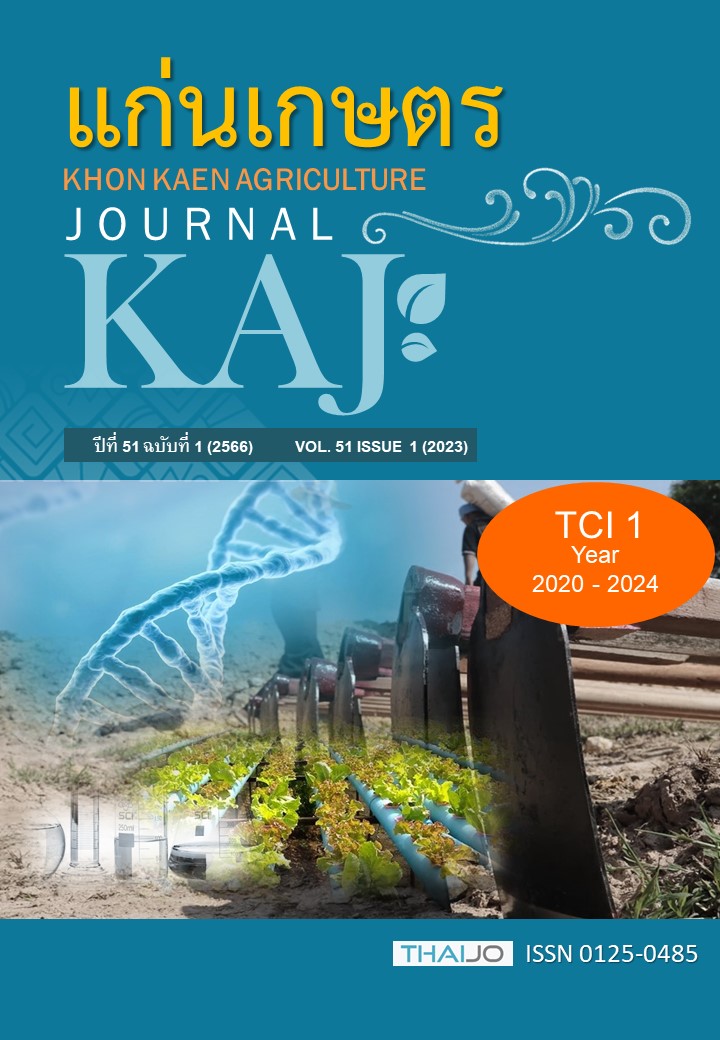การประเมินสูตรอาหารที่เหมาะสมและการศึกษาความเป็นไปได้ของการผลิตแมลงโปรตีนระดับอุตสาหกรรม
Main Article Content
บทคัดย่อ
ทั่วโลกมีการแนะนำการใช้ประโยชน์จากแมลงโปรตีนหรือแมลงวันลาย (black soldier fly; Hermetia illucens L.) เป็นแหล่งโปรตีนทางเลือกแทนปลาป่นหรือกากถั่วเหลือง ในอาหารปลา สัตว์ปีก และสุกร หนอนแมลงโปรตีนกินขยะอินทรีย์หลากชนิดในชุมชุนและผลพลอยได้จากการแปรรูปอุตสาหกรรมการเกษตรเปลี่ยนเป็นชีวมวล แหล่งโปรตีนที่มีคุณภาพสูงเหมาะสมที่จะเป็นอาหารสัตว์ในเศรษฐกิจหมุนเวียนที่ยั่งยืน วัตถุประสงค์ของงานวิจัยนี้เพื่อประเมินสูตรอาหารที่เหมาะสม โดยเน้นการนำผลพลอยได้จากอุตสาหกรรมการเกษตรในท้องถิ่นมาผลิตแมลงโปรตีน เพื่อเป็นแหล่งโปรตีนในอาหารสัตว์ และการทดสอบความเป็นไปได้ของการผลิตแมลงโปรตีนระดับอุตสาหกรรม การศึกษาประกอบด้วยสองการทดลอง คือ การทดลองที่ 1 วางแผนการทดลองแบบสุ่มสมบูรณ์ (completely randomized design; CRD) มี 9 กรรมวิธี (สูตรอาหาร) คือ 1) กากเต้าหู้ผสมอาหารไก่ อัตราส่วน 1:1 2) และ 3) เยื่อหุ้มเมล็ดถั่วลิสงผสมกับเศษผลไม้ อัตราส่วน 1:2 และ 2:1 ตามลำดับ 4) และ 5) เศษเนื้อหมูตัดแต่งผสมกับเศษผลไม้ อัตราส่วน 1:2 และ 2:1 ตามลำดับ 6) ส่วนผสมของเยื่อหุ้มเมล็ดถั่วลิสง เศษผลไม้ เศษเนื้อหมูตัดแต่ง และเศษอาหาร อัตราส่วน 1:1:1:1 7) ถึง 9) กากเบียร์แห้งผสมกับเศษผลไม้ อัตราส่วน 1:1 1:2 และ 2:1 ตามลำดับ กรรมวิธีละ 5 ซ้ำ ระยะก่อนเข้าดักแด้ (prepupa) จากอาหารทุกสูตรที่ทดสอบมีโปรตีน 44.55 – 56.64% สามารถนำมาใช้ผลิตแมลงโปรตีนเป็นวัตถุดิบทางเลือกในอาหารสัตว์ และสูตรอาหารกรรมวิธีที่ 6 เป็นสูตรที่เหมาะสมมากที่สุด เมื่อพิจารณาจากการเจริญเติบโตของตัวหนอน น้ำหนักลำตัวของระยะก่อนเข้าดักแด้ ผลผลิตรวม การรอดชีวิต อาหารที่กิน อัตราการเปลี่ยนอาหารเป็นเนื้อ และต้นทุนค่าอาหาร สำหรับการทดลองที่ 2 เป็นการทดสอบการผลิตระดับอุตสาหกรรม โดยเลี้ยงหนอนแมลงโปรตีนอายุ 5 วัน จำนวน 25,000 ตัว/กระบะ ด้วยสูตรอาหารกรรมวิธีที่ 6 ซึ่งเป็นผลจากการทดลองที่ 1 พบว่า ได้ผลผลิตของระยะก่อนเข้าดักแด้เฉลี่ย 4.15 + 0.15 กก. การผลิตขนาดใหญ่ที่เหมาะสมทำให้ต้นทุนถูกกว่าการเลี้ยงระดับห้องปฏิบัติการ
Article Details

อนุญาตภายใต้เงื่อนไข Creative Commons Attribution-NonCommercial-NoDerivatives 4.0 International License.
เอกสารอ้างอิง
A.O.A.C (Association of Official Analytical Chemists). 2000. Official Methods of Analysis. Arlington, VA, USA.
Banks, I.J., W.T. Gibson, and M.M. Cameron. 2014. Growth rates of black soldier fly larvae fed on fresh human feces and their implication for improving sanitation. Tropical Medicine and International Health. 19: 14–22.
Bava, L., C. Jucker, G. Gislon, D. Lupi, S. Savoldelli, M. Zucali, and S. Colombini. 2019. Rearing of Hermetia illucens on different organic by-products: Influence on growth, waste reduction, and environmental impact. Animals. 9 (6): 289.
Bonelli, M., D. Bruno, S. Caccia, G. Sgambetterra, S. Cappellozza, C. Jucker, and M. Casartelli. 2019. Structural and functional characterization of Hermetia illucens larval midgut. Frontiers in Physiology. 10: 204.
Cammack, J.A., and J.K. Tomberlin. 2017. The impact of diet protein and carbohydrate on select life-history traits of the black soldier fly Hermetia illucens (L.) (Diptera: Stratiomyidae). Insects. 8 (2): 56.
Feed navigator. 2021. Available online: https://www.feednavigator.com/Article/2021/02/24/Demand-for-insect-protein-could-hit-500-000-tons-by-2030 (accessed on 29 July 2022).
Gobbi, P., A.S. Martinez-Sanchez, and S. Rojo. 2013. The effects of larval diet on adult life-history traits of the black soldier fly, Hermetia illucens (Diptera: Stratiomyidae). European Journal of Entomology. 110(3): 461.
Green, T.R., and R. Popa. 2012. Enhanced ammonia content in compost leachate processed by black soldier fly larvae. Applied Biochemistry and Biotechnology. 166 (6): 1381-1387.
Griminger, P., and C.G. Scanes. 1986. Protein metabolism. PP 326–345 In: Avian Physiology, 4th edn. P.D. Sturkie, Ed. Springer Verlag, New York.
Hale, O.M., 1973. Dried Hermetia illucens larvae (Diptera: Stratiomyidae) as a feed additive for poultry. Journal of the Georgia Entomological Society. 8: 16–20.
Jucker, C., D. Erba, M.G. Leonardi, D. Lupi, and S. Savoldelli. 2019. Assessment of vegetable and fruit substrates as potential rearing media for Hermetia illucens (Diptera: Stratiomyidae) larvae. Environmental Entomology. 46 (6): 1415-1423.
Lalander, C., S. Diener, M.E. Magri, C. Zurbrugg, A. Lindstrom, and B. Vinneras. 2013. Faecal sludge management with the larvae of the black soldier fly (Hermetia illucens)-from a hygiene aspect. Science of the Total Environment. 458: 312–318.
Malakhova, D.V., M.A. Egorova, L.I. Prokudina, A.I. Netrusov, and E.A. Tsavkelova. 2015. The biotransformation of brewer’s spent grain into biogas by anaerobic microbial communities. World Journal of Microbiology and Biotechnology. 31(12): 2015-2023.
Marono, S., R. Loponte, P. Lombardi, G. Vassalotti, M.E. Pero, F. Russo, L. Gasco, G. Parisi, G. Piccolo, S. Nizza, C. Di Meo, Y.A. Attia, and F. Bovera. 2017. Productive performance and blood profiles of laying hens fed Hermetia illucens larvae meal as total replacement of soybean meal from 24 to 45 week of age. Poultry Science. 96: 1783–1790.
Mathias, D.S.T.R., P.P.M. de Mello, and E.F.C. Sérvulo. 2014. Solid wastes in brewing process: A review. Journal of Brewing and Distilling. 5(1): 1-9.
Newton, G.L., C.V. Booram, R.W. Barker, and O.M. Hale. 1977. Dried Hermetia illucens larvae meal as a supplement for swine. Journal of Animal Science. 44 (3): 395-400.
Nguyen, T.T.X., J.K. Tomberlin, and S. Vanlaerhoven. 2015. Ability of black soldier fly (Diptera : Stratiomyidae) larvae to recycle food waste. Environmental Entomology. 44: 406–410.
Oonincx, D.G., S. Van Broekhoven, A. Van Huis, and J.J. van Loon. 2015. Feed conversion, survival and development, and composition of four insect species on diets composed of food by-products. PLoS One. 10 (12): 1-20.
Parra Paz, A.S., N.S. Carrejo, and C.H.G. Rodríguez. 2015. Effects of larval density and feeding rates on the bioconversion of vegetable waste using black soldier fly larvae Hermetia illucens (L.), (Diptera: Stratiomyidae). Waste and Biomass Valorization. 6 (6): 1059-1065.
R Development core team. 2008. R: A language and environment for statistical computing. Venna, Austria: R Foundation for Statistical Computing [www.document]. URL: http://Rproject.org.
Scala, A., J.A. Cammack, R. Salvia, C. Scieuzo, A. Franco, S.A. Bufo, and P. Falabella. 2020. Rearing substrate impacts growth and macronutrient composition of Hermetia illucens (L.) (Diptera: Stratiomyidae) larvae produced at an industrial scale. Scientific Reports. 10 (1): 1-8.
Schiavone, A., M. Cullere, M. De Marco, M. Meneguz, I. Biasato, S. Bergagna, D. Dezzutto, F. Gai, S. Dabbou, L. Gasco, and A. Dalle Zotte. 2017. Partial or total replacement of soybean oil by black soldier fly larvae (Hermetia illucens L.) fat in broiler diets: Effect on growth performances, feed-choice, blood traits, carcass characteristics and meat quality. Italian Journal of Animal Science. 16(1): 93-100.
Sheppard, D.C., J.K. Tomberlin, J.A. Joyce, B.C. Kiser, and S.M. Sumner. 2002. Rearing methods for the black soldier fly (Diptera: Stratiomyidae). Journal of Medical Entomology. 39: 695–698.
St-Hilaire, S., C. Sheppard, J.K. Tomberlin, S. Irving, L. Newton, M.A. McGuire, E.E. Mosley, R.W. Hardy, and W. Sealey. 2007. Fly prepupae as a feedstuff for rainbow trout, Oncorhynchus mykiss. Journal of the World Aquaculture Society. 38(1): 59-67.
Spranghers, T., M. Ottoboni, C. Klootwijk, A. Ovyn, S. Deboosere, B.D. Meulenaer, J. Michiels, M. Eeckhout, D.P. Clercq, and S.D. Smet. 2017. Nutritional composition of black soldier fly (Hermetia illucens) prepupae reared on different organic waste substrates. Journal of the Science of Food and Agriculture. 97(8): 2594-2600.
Wang, Y.S., and M. Shelomi. 2017. Review of black soldier fly (Hermetia illucens) as animal feed and human food. Foods. 91 (6): 1-23.
Zheng, L.Y., Y.F. Hou, W. Li, S. Yang, Q. Li, and Z.N. Yu. 2012. Biodiesel production from rice straw and restaurant waste employing black soldier fly assisted by microbes. Energy. 47: 225–229.


